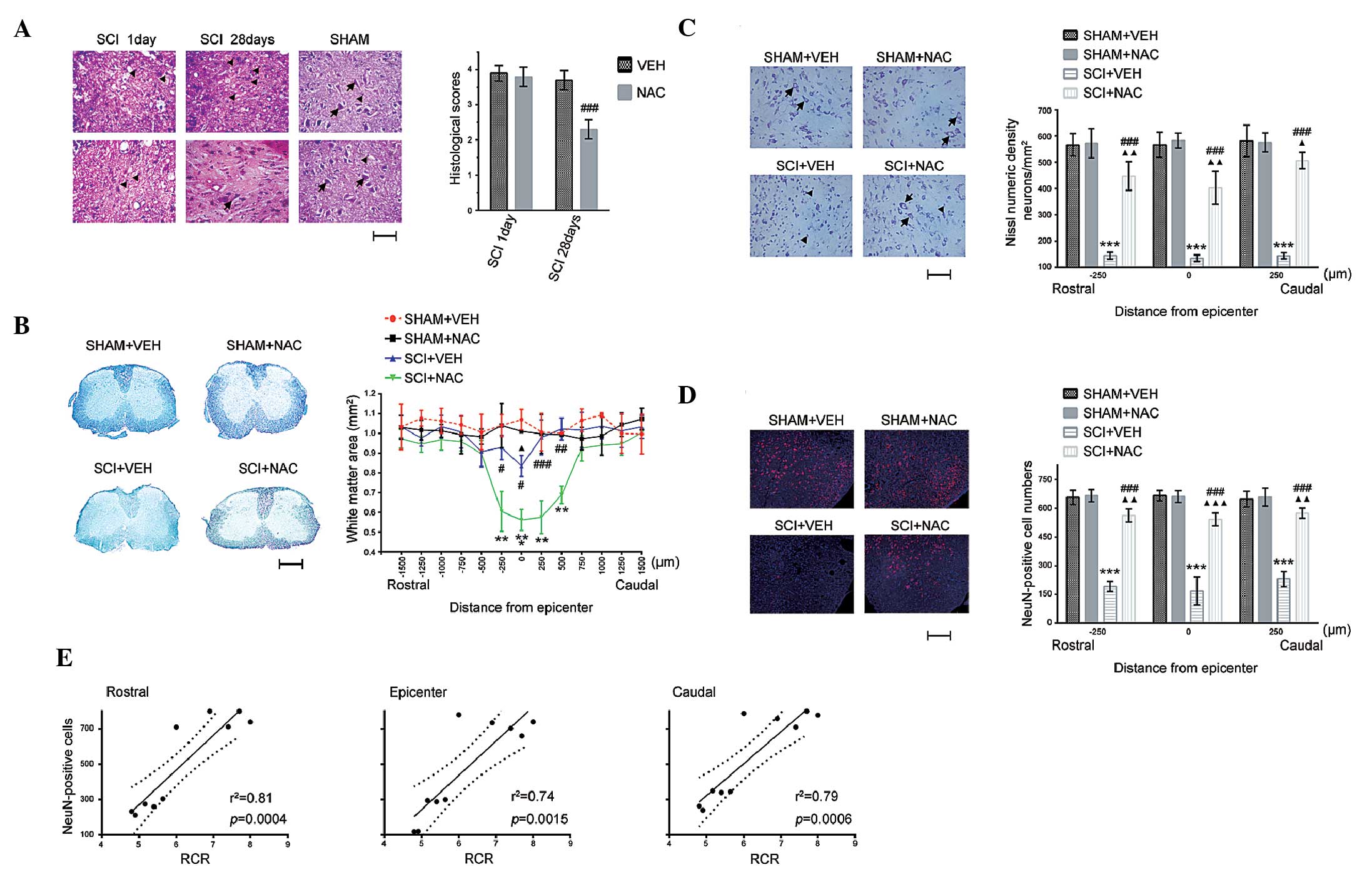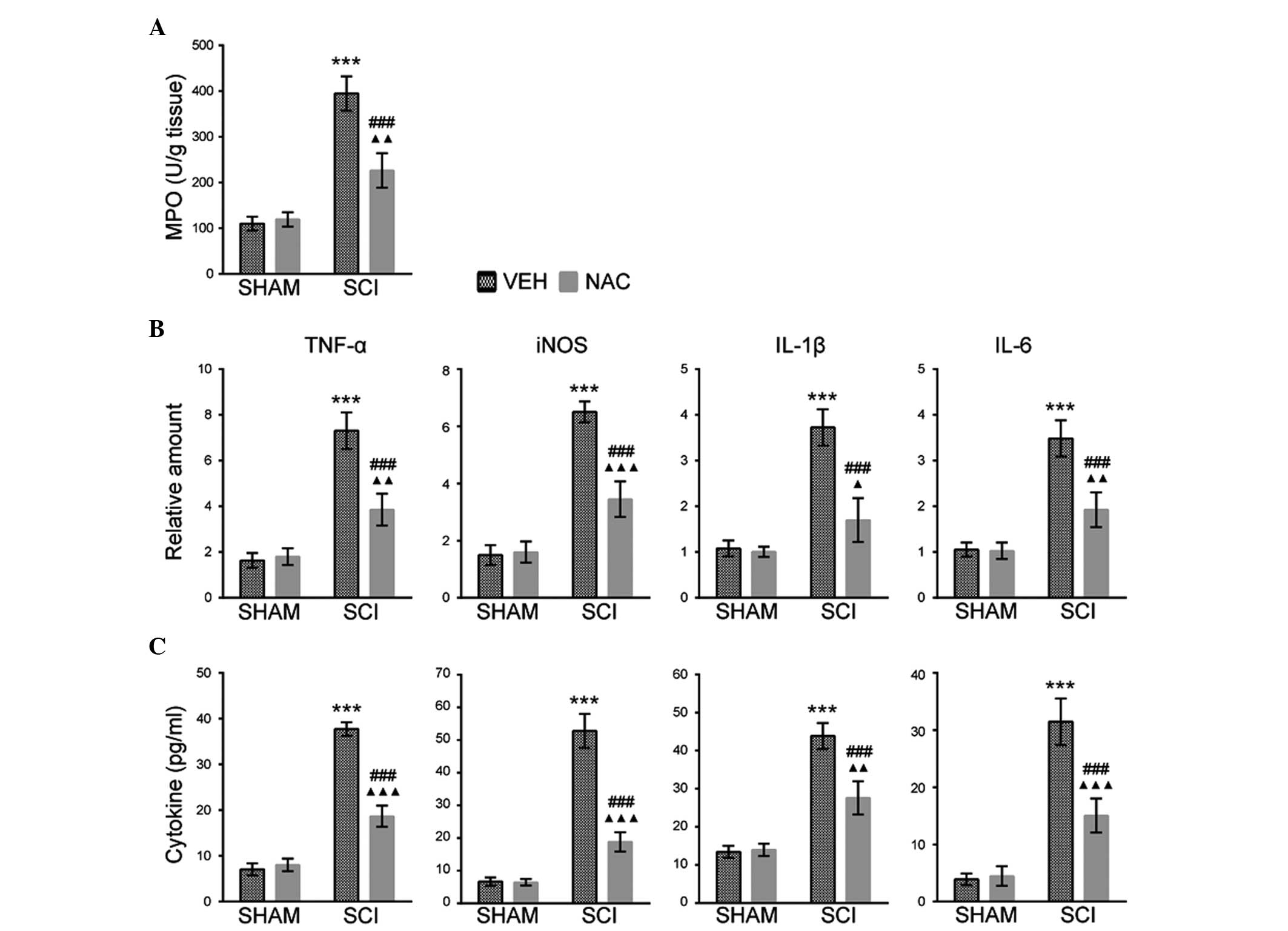|
1
|
Mautes AE, Weinzierl MR, Donovan F and
Noble LJ: Vascular events after spinal cord injury: contribution to
secondary pathogenesis. Phys Ther. 80:673–687. 2000.PubMed/NCBI
|
|
2
|
Luo J, Borgens R and Shi R: Polyethylene
glycol improves function and reduces oxidative stress in
synaptosomal preparations following spinal cord injury. J
Neurotrauma. 21:994–1007. 2004. View Article : Google Scholar : PubMed/NCBI
|
|
3
|
McEwen ML, Sullivan PG and Springer JE:
Pretreatment with the cyclosporin derivative, NIM811, improves the
function of synaptic mitochondria following spinal cord contusion
in rats. J Neurotrauma. 24:613–624. 2007. View Article : Google Scholar : PubMed/NCBI
|
|
4
|
Sullivan PG, Krishnamurthy S, Patel SP,
Pandya JD and Rabchevsky AG: Temporal characterization of
mitochondrial bioenergetics after spinal cord injury. J
Neurotrauma. 24:991–999. 2007. View Article : Google Scholar : PubMed/NCBI
|
|
5
|
Patel SP, Sullivan PG, Lyttle TS and
Rabchevsky AG: Acetyl-L-carnitine ameliorates mitochondrial
dysfunction following contusion spinal cord injury. J Neurochem.
114:291–301. 2010.PubMed/NCBI
|
|
6
|
Patel SP, Sullivan PG, Pandya JD and
Rabchevsky AG: Differential effects of the mitochondrial uncoupling
agent, 2,4-dinitrophenol, or the nitroxide antioxidant, Tempol, on
synaptic or nonsynaptic mitochondria after spinal cord injury. J
Neurosci Res. 87:130–140. 2009. View Article : Google Scholar
|
|
7
|
Patel SP, Sullivan PG, Lyttle TS, Magnuson
DS and Rabchevsky AG: Acetyl-L-carnitine treatment following spinal
cord injury improves mitochondrial function correlated with
remarkable tissue sparing and functional recovery. Neuroscience.
210:296–307. 2012. View Article : Google Scholar : PubMed/NCBI
|
|
8
|
Arakawa M and Ito Y: N-acetylcysteine and
neurodegenerative diseases: basic and clinical pharmacology.
Cerebellum. 6:308–314. 2007. View Article : Google Scholar : PubMed/NCBI
|
|
9
|
Berk M, Kapczinski F, Andreazza AC, et al:
Pathways underlying neuroprogression in bipolar disorder: focus on
inflammation, oxidative stress and neurotrophic factors. Neurosci
Biobehav Rev. 35:804–817. 2011. View Article : Google Scholar
|
|
10
|
Karalija A, Novikova LN, Kingham PJ,
Wiberg M and Novikov LN: Neuroprotective effects of
N-acetyl-cysteine and acetyl-L-carnitine after spinal cord injury
in adult rats. PLoS One. 7:e410862012. View Article : Google Scholar : PubMed/NCBI
|
|
11
|
Lee J, Kim H, Choi H, Oh T and Yune T:
Fluoxetine inhibits matrix metalloprotease activation and prevents
disruption of blood-spinal cord barrier after spinal cord injury.
Brain. 135:2375–2389. 2012. View Article : Google Scholar : PubMed/NCBI
|
|
12
|
Welin D, Novikova LN, Wiberg M, Kellerth
JO and Novikov LN: Effects of N-acetyl-cysteine on the survival and
regeneration of sural sensory neurons in adult rats. Brain Res.
1287:58–66. 2009. View Article : Google Scholar : PubMed/NCBI
|
|
13
|
Fu L, Guo Z and Longhurst J: Endogenous
endothelin stimulates cardiac sympathetic afferents during
ischaemia. J Physiol. 588:2473–2486. 2010. View Article : Google Scholar : PubMed/NCBI
|
|
14
|
Douglas SA, Vickery-Clark LM, Louden C and
Ohlstein EH: Selective ETA receptor antagonism with BQ-123 is
insufficient to inhibit angioplasty induced neointima formation in
the rat. Cardiovasc Res. 29:641–646. 1995. View Article : Google Scholar : PubMed/NCBI
|
|
15
|
Okada M and Nishikibe M: BQ-788, a
selective endothelin ETB receptor antagonist. Cardiovasc Drug Rev.
20:53–66. 2002. View Article : Google Scholar : PubMed/NCBI
|
|
16
|
Yin X, Yin Y, Cao FL, et al: Tanshinone
IIA attenuates the inflammatory response and apoptosis after
traumatic injury of the spinal cord in adult rats. PLoS One.
7:e383812012. View Article : Google Scholar : PubMed/NCBI
|
|
17
|
Lee S, Rosen S, Weinstein P, van Rooijen N
and Noble-Haeusslein L: Prevention of both neutrophil and monocyte
recruitment promotes recovery after spinal cord injury. J
Neurotrauma. 28:1893–1907. 2011. View Article : Google Scholar : PubMed/NCBI
|
|
18
|
Yang L, Jones NR, Blumbergs PC, et al:
Severity-dependent expression of pro-inflammatory cytokines in
traumatic spinal cord injury in the rat. J Clin Neurosci.
12:276–284. 2005. View Article : Google Scholar : PubMed/NCBI
|
|
19
|
Xu J, Kim GM, Chen S, et al: iNOS and
nitrotyrosine expression after spinal cord injury. J Neurotrauma.
18:523–532. 2001. View Article : Google Scholar : PubMed/NCBI
|
|
20
|
Vaishnav RA, Singh IN, Miller DM and Hall
ED: Lipid peroxidation-derived reactive aldehydes directly and
differentially impair spinal cord and brain mitochondrial function.
J Neurotrauma. 27:1311–1320. 2010. View Article : Google Scholar : PubMed/NCBI
|
|
21
|
Kanno H, Ozawa H, Dohi Y, Sekiguchi A,
Igarashi K and Itoi E: Genetic ablation of transcription repressor
Bach1 reduces neural tissue damage and improves locomotor function
after spinal cord injury in mice. J Neurotrauma. 26:31–39. 2009.
View Article : Google Scholar : PubMed/NCBI
|
|
22
|
Li N, Alam J, Venkatesan MI, et al: Nrf2
is a key transcription factor that regulates antioxidant defense in
macrophages and epithelial cells: protecting against the
proinflammatory and oxidizing effects of diesel exhaust chemicals.
J Immunol. 173:3467–3481. 2004. View Article : Google Scholar : PubMed/NCBI
|
|
23
|
Goven D, Boutten A, Leçon-Malas V,
Boczkowski J and Bonay M: Prolonged cigarette smoke exposure
decreases heme oxygenase-1 and alters Nrf2 and Bach1 expression in
human macrophages: roles of the MAP kinases ERK(1/2) and JNK. FEBS
Lett. 583:3508–3518. 2009. View Article : Google Scholar : PubMed/NCBI
|
|
24
|
Avivar-Valderas A, Salas E,
Bobrovnikova-Marjon E, et al: PERK integrates autophagy and
oxidative stress responses to promote survival during extracellular
matrix detachment. Mol Cell Biol. 31:3616–3629. 2011. View Article : Google Scholar : PubMed/NCBI
|
|
25
|
Wilson AD, Hart A, Brännström T, Wiberg M
and Terenghi G: Delayed acetyl-L-carnitine administration and its
effect on sensory neuronal rescue after peripheral nerve injury. J
Plast Reconstr Aesthet Surg. 60:114–118. 2007. View Article : Google Scholar : PubMed/NCBI
|
|
26
|
Zhang CG, Welin D, Novikov L, Kellerth JO,
Wiberg M and Hart AM: Motorneuron protection by N-acetyl-cysteine
after ventral root avulsion and ventral rhizotomy. Br J Plast Surg.
58:765–773. 2005. View Article : Google Scholar : PubMed/NCBI
|
|
27
|
Yan CY and Greene LA: Prevention of PC12
cell death by N-acetylcysteine requires activation of the Ras
pathway. J Neurosci. 18:4042–4049. 1998.PubMed/NCBI
|
|
28
|
Novikova LN, Novikov LN and Kellerth JO:
Survival effects of BDNF and NT-3 on axotomized rubrospinal neurons
depend on the temporal pattern of neurotrophin administration. Eur
J Neurosci. 12:776–780. 2000. View Article : Google Scholar : PubMed/NCBI
|
|
29
|
Manfridi A, Forloni GL, Arrigoni-Martelli
E and Mancia M: Culture of dorsal root ganglion neurons from aged
rats: effects of acetyl-L-carnitine and NGF. Int J Dev Neurosci.
10:321–329. 1992. View Article : Google Scholar : PubMed/NCBI
|














